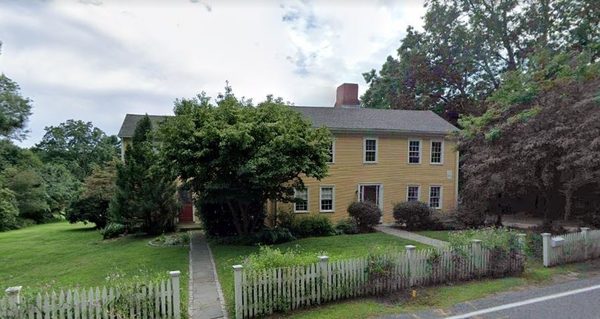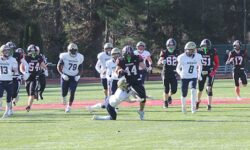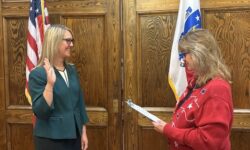While a regular Needham family was living there not long ago, this house will soon be turned into a library in celebration of N.C. Wyeth.
By James Kinneen
Hometown Weekly Reporter
Picture Paul Revere’s famous “Midnight Ride.” If you're familiar with the image of the famed founding father galloping past a basic eighteenth-century home as a pair of nightcap-wearing colonials stick their heads out of their candlelit second floor windows, then you’re likely thinking of N.C. Wyeth’s famed illustration of Longfellow’s poem. But while Revere never actually passed the Needham home depicted in the image, you probably have. And thanks to a foundation established by Linda Bean, you and your kids will likely be visiting it sometime in the future.
A huge fan of American artist and illustrator N.C. Wyeth, Linda Bean, the granddaughter of LL Bean cofounder Leon Leonwood Bean, was in the process of making the N.C. Wyeth Trail, an app which would act as a virtual tour of Wyeth’s life from his childhood in Needham to the spot in Utah where he watched and illustrated the merging of two transcontinental railroads with a golden spike. The idea would be that the tour would create something akin to a pilgrimage for Wyeth fans, with your smartphone’s GPS acting to reward you for visiting each place, almost like in Pokemon Go.
While looking to explore some of the places in Needham for the virtual tour, Bean came across Wyeth’s grandfather’s home on South Street and saw that it was for sale. She made the decision to form a foundation and buy the home to convert it into a public library dedicated to Wyeth, which will be available to visit by private appointment.
“To us who have formed a foundation to create libraries and celebrate [Wyeth’s] life and work, this is the Holy Grail location,” she explained. “It is the street he lived on, the house he owned, his grandfather’s place where he grew up working in the gardens for his granddad - and of course it’s right next to his own home, which is still privately owned. So, we’re thrilled.”
While Wyeth - famous for his illustrations in Scribner’s printings of "Treasure Island", "The Deerslayer", "The Last of the Mohicans", and "The Mysterious Island", as well as his independent artistic work - will be the focal point of the museum, the story of the house involves many famous American historical figures.
First, there is Wyeth's grandfather, Denys Zirngiebel, who owned the house while N.C. lived next door. No slouch in his own right, Zirngiebel was a hugely successful botanist who introduced both the carnation and giant pansy to the United States, which he grew on the property Bean’s foundation purchased, in large greenhouses. Zirngiebel’s pansy business was highly successful and even shipped flowers to the White House. This is why Needham has always celebrated the pansy as its town flower.
One of Zirngiebel’s family friends was none other than Henry Wadsworth Longfellow. Years before N.C. Wyeth would illustrate his poems for the book “The Children’s Longfellow”, Longfellow would visit Zirngiebel and his wife, and is said to have liked to gaze out at the Charles River (it’s believed he wrote “To the River Charles” at the location) so much that there’s currently a stump by the river that was once part of the “Longfellow Tree.” To commemorate his life, there will be two rooms devoted to the poet. One will feature the book of poems Wyeth illustrated, while the other will be for children to play in.
“There’s a smaller room that looks towards the water upstairs that’s always been known as the Longfellow Room,” Bean explained. “And that’s because legend has it Henry Longfellow visited there. He was friends with Mrs. Zirngiebel. I don’t know what the history of it is, but there’s even the stump of a tree down by the water that’s known as the Longfellow Tree. We’re going to use that room as a place for children to come, maybe preschool aged children before they come to the one at the History Center, the schoolhouse room. And we’re going to decorate this room with toys and books and we’re going to feature a book that N.C. Wyeth illustrated called “The Children’s Longfellow”, in which there are poems and the story of Hiawatha and other stories Longfellow wrote. The cover is the illustration of a canoe with an Indian, and on the bow is a squirrel. It’s a very sweet picture. So we’re going to paint it the colors of that image and have it as a place where young children could come and be read stories, not only from that book but other stories. It’s just a fun place where pre-students can learn about New England history, Needham history, the artist N.C. Wyeth, and the poet Henry Longfellow.”
As for Wyeth himself, he grew up in Needham until he left to go to an illustration school in Delaware. While there, he met a woman he would end up marrying, whom he lived with in Pennsylvania. They had five children they raised there, but Wyeth dearly missed Needham, so he eventually bought his grandfather’s house (which Bean’s foundation now owns) and brought his five children (including a four-year-old Andrew Wyeth) back to his hometown. Unfortunately, the town wasn’t quite how he remembered it being, around twenty years since he left, and his children missed Pennsylvania - prompting the family to go back.
“He brought his wife and all five children, who ranged in age from 4-13. Andrew Wyeth, who became very famous after N.C. Wyeth, was his youngest son, and he was born in 1917, so he would have been four. And he sent them to the same schoolteacher he would have had. But you know, he remembered the town romantically as in his childhood. When he got there 20 years later after he’d left, since he left at age 20 and came back in his 40s, the population had increased by six-fold. It was a very popular community to develop and live in and it wasn’t the rural town so much that he remembered. Additionally, while he had many wonderful memories of his childhood there, his own children hadn’t grown up there. They’d grown up in Chadds Ford, Pennsylvania, and had wonderful memories of that, so they began to get homesick. Those two things prompted them to move back to Pennsylvania after a few years.”
With Needham families having lived in it until Bean’s foundation purchased it, the house does have some changes since Wyeth lived there, including a couple of added rooms and an addition that features a modern kitchen. Still, Bean explained, “It’s remarkably similar to what we think was there when he was there,” with her noting “the original kitchen with the enormous fireplace is still there, and fireplaces all through the homes. There’s three on each floor. That’s how they heated the house in those days, but in between are the radiators, that came in. They’re still there and we’re going to leave those there.”
Bean doesn’t think there will be any original artwork at the library, believing that should probably be kept in a museum setting. However, it will feature “a library of the best quality” with original, first-edition books in their original dust jackets. Manuscripts that need protection, all kinds of special papers and prints, and photographs will be housed there, as well. The idea is that the library will become a destination for Wyeth lovers, both domestic and international.
After reading Douglas Allen Jr.s book about Wyeth around twenty years ago, Bean became interested in collecting Wyeth’s work, so much so that “it’s sort of taken over a good part of my life. I’m turning 80 this month and I’m so happy to think it will continue, that we will have this wonderful collection available in Massachusetts - and to the country and the world, really.”























